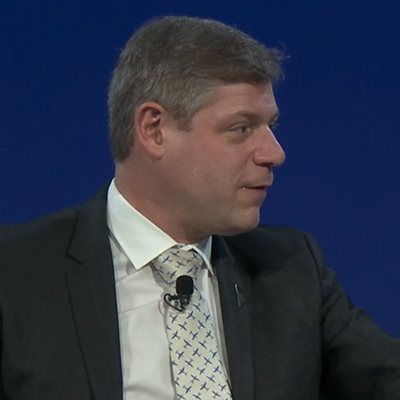Commercial aviation can be carbon-free, say engineers and commercial airline planners who see the changes coming first in smaller electric aircraft built specifically for commuting and able to slip in and out of airports abandoned by major carriers.
Privately held Eviation, of Washington state, is one of a handful of companies designing electric aircraft powered entirely by batteries. Alice, its sleek nine-passenger electric commuter, successfully flew for the first time in September 2022, reaching an altitude of 3,500 feet. (See Electric Commuter Plane Takes Flight in Wash.)
 Eviation Aircraft CEO Gregory Davis | BloombergNEF
Eviation Aircraft CEO Gregory Davis | BloombergNEF
Eviation CEO Gregory Davis appeared last week at a BloombergNEF conference in San Francisco to talk about the company’s plans. He was joined in a seminar by representatives of Alaska Airlines and European aerospace company Airbus.
“We’ve shown that the technology exists to make an electric airplane, and it’s today’s technology,” said Davis. “We’ve addressed the technology of the batteries … in terms of the architecture and the certification of those batteries.”
The design of the aircraft — motor-driven props at rear behind the batteries and passengers in the front — was driven by “where we needed to put the batteries to make the aircraft perform properly,” said Davis.
The sleek fuselage and wings as aerodynamically efficient as possible were designed to maximize lift, he added.
“We’ve been working with the [Federal Aviation Administration]. We’re building a commuter category aircraft. So it is certified under a set of standards that are complimentary for the size of the airplane.”
The company is projecting it can begin selling Alice to fly routes of 250 nautical miles as soon as 2027, said Davis.
“That’s a regional market. It’s a market that really hasn’t been serviced globally and effectively in the past 20 to 30 years,” he added, explaining that airlines gradually discontinued service as airplanes became larger.
The switch to electric will not only be clean; it will have a profound impact on how commercial aviation serves the public, he argued.
Pasha Saleh, head of corporate development for Alaska Airlines, said the company is working with ZeroAvia, a company planning to incorporate a 3-MW fuel cell into an existing conventional turbo-prop aircraft, a De Havilland DHC-8-400.
“Range is overrated,” he said. “The De Havilland has a 1,200-mile range, but airlines don’t use it for 1,200 miles. It doesn’t have a proper galley for heated food. You don’t want to be on a turboprop for three and a half to four hours.
“It turns out that 90% of the routes we use [the DHC-8] on are below 200 miles; some are 98 miles long,” he said, meaning the airplane is using just 15% of its capacity. “It really comes down to what is the seat cost, the mile cost of operating.
“And that’s what’s exciting to me when I look forward five to 10 years, is that with these new technologies — whether they’re pure hydrogen, electric, hybrid, whatever it is — as an airline, we want to find the right niche for the market we’re using, because right now, it’s not all just about one variable, like range.”
 Hugo Wagner, Airbus | BloombergNEF
Hugo Wagner, Airbus | BloombergNEF
Hugo Wagner, an executive with Airbus, agreed.
“I think many people don’t realize that … aircraft gas turbines as of today aren’t really optimized for some critical parts of the journey, namely the taxi, takeoff and landing part, meaning that actually almost 60% of the fuel consumption of the aircraft is below the 2,000-nautical-mile range.”
Davis added, “What we’re doing is we’re taking the technology, and we’re designing for the way that people are actually going to use the plane.”
The U.S. has 5,000 airports, he added, but only 500 are actively used, he said.
“So, 60% of the population of the United States lives within 10 miles of an airport, and 95% lives within 25 miles of an airport. And yet, you’re going to spend 45 minutes to an hour and a half getting to the airport to get on your flight.
“We’re not using our infrastructure right now. … An electric aircraft and sustainable aircraft mean that the operating economics are flipped upside down. So instead of a longer-range flight being the most economically efficient flight for a turbine aircraft, for an electric airplane, you don’t need to climb for efficiency, so there’s no burden of climbing up to 25,000 feet to save on fuel if your aircraft is equally efficient at sea level as it is up at altitude.
“And moreover, with that your operating economics are the same on the first mile as on the last, so there’s no incentive to stretch your flight to maximize the point-to-point utilization of fuel. On the airplane, your electrons get consumed the same way.”


